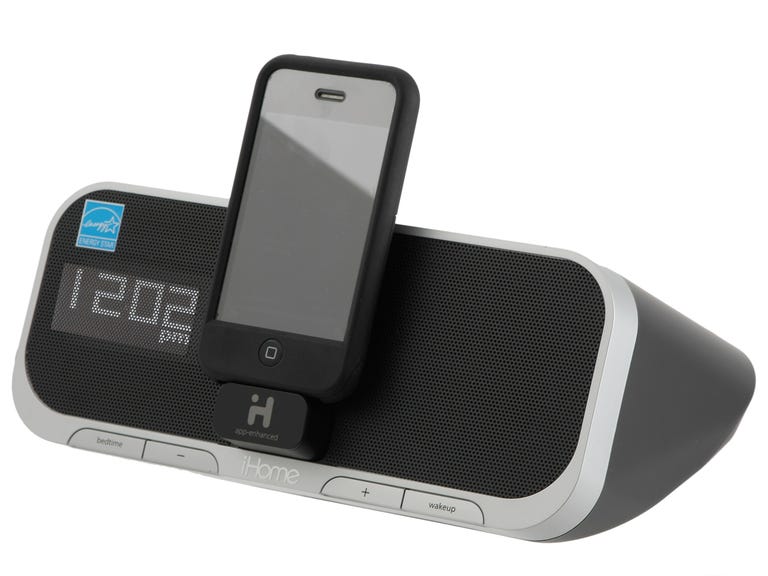 Why You Can Trust CNET
Why You Can Trust CNET iHome iA5 alarm clock review: iHome iA5 alarm clock
iHome iA5 alarm clock
iHome dubs its iA5 an "app-enhanced" alarm clock, which is exactly what it sounds like: this unit is designed to work with iHome's iPhone app, which means you probably shouldn't bother reading this review unless you have an iPhone or iPod Touch to connect to its dock.
The Good
The Bad
The Bottom Line
From a design standpoint, the iA5 isn't terribly distinguished-looking, but it looks attractive enough with a speaker/dock system that slants back and leaves your iPhone or iPod Touch sitting in a lightly reclined position. The speaker is a little deeper and bigger than you'd think looking at it from the front, measuring 3.9 inches high by 5.83 inches wide by 9.34 inches deep. In other words, if you have a small nightstand, adding the iA5 won't leave a lot of spare room.
On its own--without a compatible Apple device connected to it--the iA5 has little in the way of features. There's no AM/FM radio and there's just a single alarm (on the connectivity front, you do get an auxiliary input for connecting other devices), but there is a separate time display to the left of the iPhone dock, so you always know the time. However, once you download the free iHome app from the App Store--it's called iHome + Sleep--and dock your iPhone in the iA5, things get a lot more interesting. You suddenly have a very feature-rich clock radio that has a touch-screen display (you can sync the time on your iPhone with the time on the iA5's display with a touch of a button).
One of the app's primary attributes is the ability to set various alarms using "sleep cards" that can be swapped in and out of a virtual punch-card system. These alarms can be set to go off on certain days, so you can easily set up weekday and weekend alarm schedules or even special nap times.

Beyond that, the app has integrated weather updates (the app automatically displays a stripped-down version of the weather forecast from the Weather Channel based on your location, or you can set your location manually) and you can even set the app to automatically post messages to your Twitter and Facebook accounts when you wake up or go to sleep. We're not sure you're going to want or need all the options that are available, but it's kind of cool that there's so much here.
The app also keeps statistics of what times you wake up at, how many times you hit the snooze bar, and what songs you like to wake to most frequently. You can adjust such things as bass and treble on the unit itself (yes, there are some buttons), but you can make those same adjustments from within the iPhone app, as well as fine-tune other settings. (Note: you can use the app with other iPod speakers but some functions, such as the stat keeping, will be disabled, though the alarms will work just fine).

Though the app isn't perfect, iHome has worked out some early bugs and continues to improve the app and make small feature enhancements. (A full accounting of the app's features is available at iHome's Web site.) All in all, the concept of making what's essentially a robust, software-upgradable alarm clock is a great way to go. That said, it would be more ideal if the app automatically launched when you docked your iPhone (alas, you have to launch it yourself). It's also worth pointing out that if you have a bulkier iPhone case, you might have some trouble docking your unit, but you should make a connection just fine with the standard slimmer cases (yes, your device charges when docked).
The iA5's not going to blow you away with its sound, but it certainly sounds better than the typical clock radios of yesteryear, including some of Sony's Dream Systems. For those living in dorm rooms or smaller bedrooms, it can serve as a passable primary sound system (barely), but the reality is that it's more suited to serving up background music at mid to low volumes. (Yes, the iA5 is GSM-shielded, so a docked iPhone won't cause any annoying interference on the speaker.)
The dearth of a built-in radio means that you'll need to use your iPhone/iPod Touch for anything you want to listen to. That's fine if you've loaded it up with lots of music (iTunes) or plenty of streaming apps (Pandora, Last.fm, AOL Radio, Sirius XM, NPR, etc.), or if you've bookmarked iPhone-compatible streaming sites. Just don't expect quick and easy access to your local AM/FM stations.
We also have a handful of design gripes. The dock locks the iPhone/iPod into the upright (portrait) position; that means you can't watch videos in the preferred landscape orientation, and the phone's top blocks easy access to the snooze button--not good for groggy wakeups. We were also disappointed that brightness adjustments (for the clock, the top power icon, and the iPhone screen) were all manual; at this price, we would've liked to have seen autobrightness adjustment via ambient light sensors. None of these are deal-breakers in and of themselves (for us, anyway), but taken together, they might give you reason for pause.
The iHome iA5 lists for $100, but can be had for about $10 less online. For what you get in terms of sound and build quality, that's a bit expensive (we'd like to see this more in the $60 to $70 range), but the app is free, so you could argue that you're paying the extra 25 bucks or so for that software--and the updates that come with it. So long as you're OK with that value equation--and you don't mind any of the design caveats listed above--we have no problem recommending the iA5, which delivers on its billing as an "enhanced" alarm clock.


